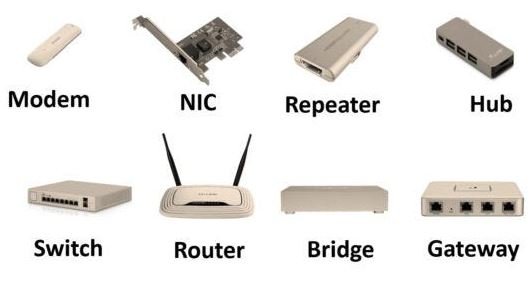
In the field of networking, numerous devices play critical roles in guaranteeing effective and seamless communication between computers and other devices. Repeaters, hubs, switches, routers, modems, and network antennas are among the most important networking device
Table of content
Repeaters
Repeaters are vital in modern networking because they expand the range of network signals, ensuring consistent connectivity across huge distances. This is especially important in large residences, office buildings, and environments with numerous networked devices, such as smart homes and IoT ecosystems.
Features:
- Signal Amplification: Receives and boosts weak network signals.
- Extended Coverage: Increases the range of Wi-Fi and network signals.
- Compatibility: Works with various network types and devices.
- Ease of Installation: Simple setup without requiring advanced technical skills.
Advantages:
- Enhanced Connectivity: Ensures strong and consistent network access throughout large spaces.
- Support for Remote Work and Learning: Provides reliable internet for video conferencing, online classes, and remote collaboration.
- Cost-Effective: More affordable than installing multiple access points or complex network infrastructure.
- IoT Integration: Maintains connectivity for smart devices, enhancing home automation and security.
- Future-Proofing: Scalable solution that adapts to increasing network demands and higher data speeds.
Hubs
Hubs are basic networking devices that connect several computers or other network devices in a local area network (LAN). They act as a central connection point, making it simple to establish and develop a network. Although more modern devices, such as switches, have essentially supplanted hubs in many settings, they remain useful in specific situations due to their simplicity and cost-effectiveness.
Features:
- Central Connection Point: Allows multiple devices to connect and communicate within a network.
- Layer 1 Device: Operates at the physical layer of the OSI model, forwarding data to all connected devices.
- Port Configuration: Typically comes with multiple ports, commonly ranging from 4 to 24.
- Broadcasting: Sends incoming data packets to all ports, without distinguishing the intended recipient.
Advantages:
- Simplicity: Easy to install and use, requiring minimal configuration.
- Cost-Effective: More affordable compared to switches and other advanced networking devices.
- Network Expansion: Facilitates the quick and straightforward expansion of a network by adding more devices.
- Basic Connectivity: Provides essential connectivity for small, simple networks without the need for advanced features.
Switches
Switches are essential components of contemporary networking, connecting various devices inside a local area network (LAN) and effectively managing data traffic. They are critical for guaranteeing rapid, dependable, and secure communication among devices. Switches are a step above hubs, offering more intelligent data handling and minimizing network congestion.
Features:
- Layer 2 Device: Operates at the data link layer of the OSI model, using MAC addresses to forward data to the correct destination.
- Data Packet Filtering: Directs data packets only to the intended recipient device, enhancing network efficiency.
- Multiple Ports: Comes with a range of port configurations, from 4 to 48 or more, supporting extensive network connections.
- VLAN Support: Enables the creation of virtual local area networks (VLANs) for improved network segmentation and security.
- Managed and Unmanaged Options: Managed switches offer advanced configuration and monitoring capabilities, while unmanaged switches provide plug-and-play simplicity.
Advantages:
- Increased Efficiency: Reduces network congestion by directing data only to the appropriate devices, unlike hubs that broadcast to all connected devices.
- Improved Performance: Supports higher data transfer rates and can handle more simultaneous connections, making it ideal for larger and more demanding networks.
- Enhanced Security: VLAN support and traffic management features help segment and secure the network, protecting sensitive data.
- Scalability: Easily accommodates network expansion, supporting additional devices and increasing network size without significant performance loss.
- Reliability: Provides a stable and consistent connection, crucial for business operations, online gaming, streaming, and other high-bandwidth activities.
Routers
Routers are fundamental devices in networking, responsible for directing data between different networks. They are essential for connecting local area networks (LANs) to wide area networks (WANs) such as the internet. Routers play a crucial role in home, office, and enterprise networks, ensuring data reaches its destination efficiently and securely.
Features:
- Layer 3 Device: Operates at the network layer of the OSI model, using IP addresses to route data packets to their destinations.
- WAN and LAN Ports: Provides multiple ports for connecting to both the internet (WAN) and local devices (LAN).
- Wireless Connectivity: Many routers include Wi-Fi capabilities, allowing wireless devices to connect to the network.
- Security Features: Built-in firewalls, VPN support, and other security measures protect the network from unauthorized access and cyber threats.
- Quality of Service (QoS): Manages and prioritizes network traffic to ensure optimal performance for critical applications.
- Dual-Band and Tri-Band Options: Supports multiple frequency bands (e.g., 2.4 GHz and 5 GHz) to reduce interference and improve network performance.
Advantages:
- Internet Connectivity: Enables multiple devices to access the internet simultaneously, essential for both home and business environments.
- Network Management: Allows for efficient management of data traffic, ensuring data is routed through the most efficient paths.
- Enhanced Security: Protects the network with advanced security features, preventing unauthorized access and safeguarding sensitive data.
- Wireless Networking: Facilitates wireless connections, providing flexibility and mobility for users and devices.
- Scalability: Supports network expansion, allowing more devices to be connected without significant performance degradation.
- Optimized Performance: QoS and band management features ensure that high-priority applications receive the necessary bandwidth for smooth operation.
Modems
Modems (short for modulator-demodulator) are crucial networking equipment that allow internet access over a variety of communication lines, including telephone lines, cable networks, and fiber optics. They are essential for transforming digital data from a computer into analog signals that can be delivered across these lines, and vice versa.
Features:
- Signal Conversion: Converts digital signals from a computer into analog signals for transmission and then back to digital signals for reception.
- Types of Modems: Includes DSL modems, cable modems, fiber-optic modems, and satellite modems, each tailored to specific types of internet connections.
- Integrated Functions: Many modern modems come integrated with routers, providing both internet access and network routing in a single device.
- Ethernet Ports: Offers ports to connect multiple devices via Ethernet cables for wired internet access.
- Wi-Fi Capability: Some modems have built-in Wi-Fi, enabling wireless connectivity for various devices.
Advantages:
- Internet Access: Provides the crucial function of connecting a local network to the broader internet, enabling online activities such as browsing, streaming, and communication.
- High-Speed Connectivity: Modern modems support high-speed internet connections, essential for activities requiring significant bandwidth, such as online gaming and HD video streaming.
- Versatility: Available in different types to suit various internet service providers (ISPs) and connection types, ensuring compatibility with a wide range of services.
- Cost-Efficiency: Integrated modem-router devices reduce the need for multiple devices, saving space and cost while simplifying setup and management.
- Stable Connection: Ensures a reliable and stable internet connection, which is crucial for both personal and professional use.
Network antennas
Network antennas deliver and receive wireless signals. They are key components of wireless networking equipment like routers and access points that determine the wireless signal’s range and quality. Antennas can be omnidirectional or directional, and each serves a particular purpose.
Features:
- Omnidirectional and Directional Types: Omnidirectional antennas transmit and receive signals in all directions, while directional antennas focus signals in specific directions, offering higher gain and longer range.
- Frequency Bands: Antennas are designed to operate within specific frequency bands, such as 2.4 GHz and 5 GHz, depending on the wireless standard being used (e.g., Wi-Fi 4, Wi-Fi 5, Wi-Fi 6).
- Gain: The gain of an antenna determines its ability to focus signal strength in a particular direction or over a specific area, influencing its coverage range.
- Mounting Options: Antennas come in various mounting options, including ceiling-mounted, wall-mounted, and pole-mounted configurations, allowing for flexible installation in different environments.
- Weatherproofing: Outdoor antennas are often weatherproofed to withstand harsh environmental conditions, ensuring reliable performance in outdoor settings.
Advantages:
- Extended Coverage: Network antennas expand the coverage area of wireless networks, enabling connectivity over larger distances and in areas with weak signal strength.
- Improved Signal Strength: By focusing and amplifying signals, antennas enhance signal strength and quality, reducing signal loss and improving network performance.
- Better Throughput: Higher gain antennas can increase data throughput rates, allowing for faster and more reliable wireless communication.
- Flexibility and Versatility: Antennas can be deployed in various configurations and environments, making them suitable for both indoor and outdoor applications.
- Cost-Effectiveness: Upgrading or adding antennas is often more cost-effective than installing additional access points or repeaters, providing a scalable solution for expanding network coverage
Understanding the roles and functionalities of these networking devices is crucial for setting up and maintaining an efficient network. Whether you’re enhancing your home Wi-Fi, setting up a small office network, or managing a complex corporate network, choosing the right device will ensure optimal performance and connectivity.
View more Topic:
BEST COMPUTER ACCESSORIES TO IMPROVE YOUR COMPUTER SYSTEM
COMPONENTS & REPLACEMENT PARTS
BEST 10 CAMERA ACCESSORIES FOR YOUR PHOTOGRAPHIC JOURNEY

Drop Kick

Sun & Sand Sports
c


















